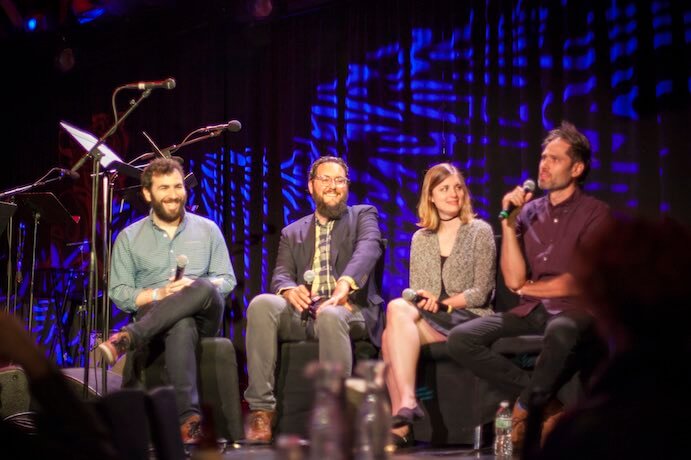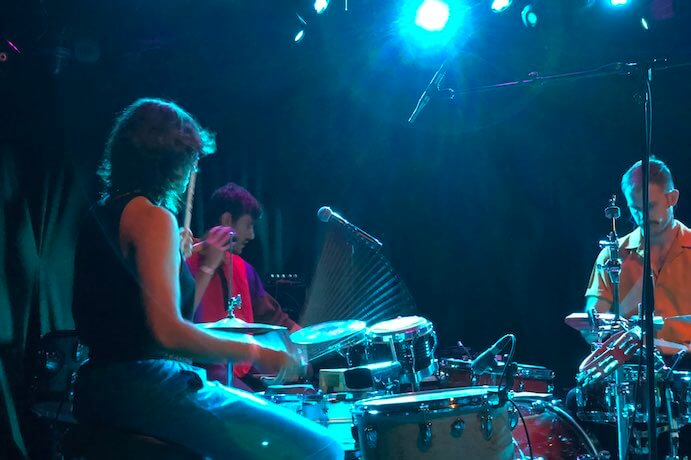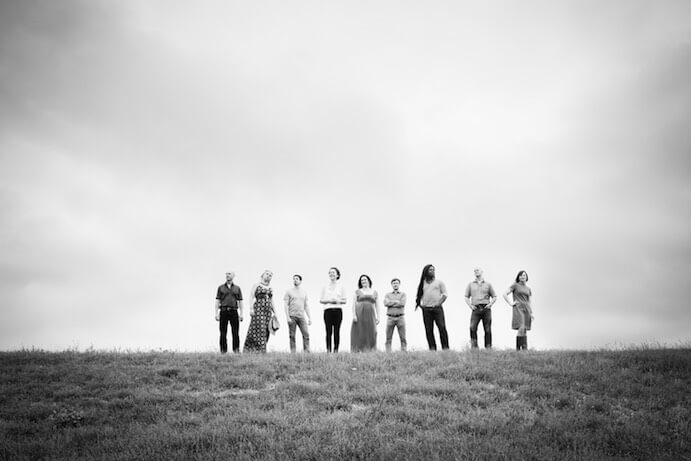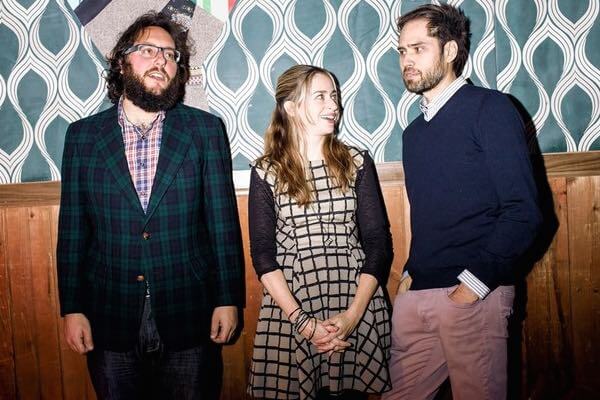Navigating the ever-changing tides of album-based musical projects may seem like an immense risk, even to those knowledgeable of today’s winds and currents. However, New Amsterdam Records continues to be a beacon. After ten years and over 100 albums, the label is far from coasting with landmarks in sight. In fact, they are deepening their commitment to unique and visionary artists in some key areas, which you can directly support through their end-of-year fundraiser. Co-Founders and Artistic Directors Judd Greenstein, Sarah Kirkland Snider, and William Brittelle took a moment to collaboratively answer a few questions about their dedication to helping artists build sustainable lives and the importance of a community-based cooperative record label.
New Amsterdam Records is a leader in supporting artists whose work lies outside of traditional music industry infrastructure and staying committed to a post-genre new music community. How do you continue to highlight distinctive musical voices without becoming ensnared in the trappings of genre markers?
It’s hard to remember now, but even 10 years ago, the notion that composers might be equally open to all influences, rather than centering their compositional practice around specific norms from Western classical music, was somewhat radical. Today, this open framework is much more broadly accepted, though still far from universal. But at the time we founded New Amsterdam Records, we felt—as composers working in the field—that there was a kind of music we wanted to support that did not have a home in the existing musical infrastructure. This music was itself full of infinite variety, and the catalogue we’ve released in the past decade is a testament to that fact.
This variety stems from the inherent variety of individual composers not just as composers, but as listeners, each with a unique experience of listening to music in the world, and each therefore with a unique way of manifesting that experience in newly-created art. This is what we call a musical “voice,” and the voices of composers we release draw from an innumerable set of influences. A post-genre approach to composition inherently breeds a distinctiveness in those composers’ musical voices. And the more we do what we say we are trying to do, as curators of the label, the more we will attract distinctive voices that together represent an ever-wider range of musical possibility. In other words, we highlight distinctive musical voices by creating space for those voices to become as distinctive as possible! Marketing and publicity can be tricky because writers and consumers like shorthand signals to know what something sounds like. We follow artists’ lead in the way they want to talk about their music, and when in doubt, we tend to favor descriptors that emphasize mood, tone, craft, and influence, rather than style and genre per se.

New Amsterdam Records Oral History Panel–Photo by Trevor Pour
In which ways are the needs of the artists you serve the same as in previous years and in which ways are they different after your ten years of experience?
The need of the artist vis a vis record production has always been the documentation of a vision. To build sustainable careers and gain access to opportunities in line with the work they truly want to create, it’s immensely helpful to have documentation of their vision in its ideal incarnation. What has changed over the years is the way income and interest are generated from album activity. With the advent of streaming and its decimation of sales, especially for niche markets like ours, artists are more and more reliant on secondary income like commissions and booking opportunities that emerge via interest in their albums. So much of the music coming out on New Amsterdam Records is unsupportable in the standard industry model, yet there is more and more public interest internationally in music that is highly personal and transcends traditional and outdated genre distinctions.
As a label, we’re thus leaning more heavily in the non-profit direction and relying on fundraising to support our label activities. Over the past ten years, the press landscape has changed significantly, especially here in New York. Many outlets have shrunk their staffs and become much more conservative in their coverage. In response, it’s become much more important to self-generate interest in our projects via social media and various partnerships.
How do the Composers Lab and your comprehensive education outreach efforts align with your dedication to community, artistic diversity, and stylistic freedom?
It’s become quite clear to us over the last few years that the desire for greater stylistic freedom is shared by composers from all over the world. Thus far, our workshops have featured participants from New Zealand, Mexico, Sweden, Australia, England, and many states across the US. Our Composers Lab is a virtual place for like-minded artists from disparate backgrounds to connect and problem-solve together. The Composers Lab is designed to accommodate artists of any educational background, whether doctoral-level or self-taught, and it serves as our front line for bringing new and diverse voices into the New Amsterdam universe. Our plans to expand our educational programming (to include project development/production, live sound, and mixing labs) will further our mission of offering an extremely affordable support system for artists assimilating their influences, charting their own path, and building their own infrastructure.

Tigue performs at New Amsterdam Records’ 10th anniversary celebration–Photo courtesy of New Amsterdam Records
While many other labels dedicated to new music (and even commercial music) are scaling back or closing altogether, you’ve made a commitment to double your releases in 2019. How will The Windmill Series, your new digital-only set of releases, allow you to serve artists and listeners?
We’ve known for some time that it was not viable to be a commercial record label while truly serving the needs of our diverse community of musicians. That is why New Amsterdam Records became a non-profit, which has allowed us to soften the otherwise-deadly blow that streaming has given to all record label revenue, in every area of music. That also means we can expand to meet the demand for our services from artists, and offer more music to fans of our label.
The Windmill Series accomplishes both of those goals, creating a more flexible, lower-overhead platform for projects that are more newly-developed or more experimental (from the perspective of the artists themselves). We can allow artists to try things out without the pressure of a full label release, and on shorter notice than a full release would require. The Windmill Series also allows us to make our Bandcamp subscription series much more attractive, by giving subscribers an exclusive window where only they can hear the Windmill releases, plus exclusive subscription-only content sprinkled throughout the year.
As our reputation as a label has grown, along with the reputations of the artists we represent, we’ve looked for ways to continue to serve the kinds of artists who we were when we started the label–younger, not yet as well-known, with fewer opportunities at our disposal. We don’t want to be a home only for the next Missy Mazzoli or Darcy James Argue album (though of course we will continue to do so for as long as they want to work with us!); we also want to find the next Missy or Darcy and all the ensembles that will turn into the Roomful of Teeth or NOW Ensemble of the 2020s and 30s. That’s part of our self-imposed mandate and the Windmill Series is a major step forward in that direction.

Roomful of Teeth–Photo by Bonica Ayala
In which ways could we strengthen the information pipeline to help eager listeners find out about new releases from New Amsterdam Records or the new music community at-large?
Listeners have never before been so bombarded with new music, the possibility for discovering new music, or recommendations for new music. Despite the diminishing number of professional music journalists in major publications, there’s more writing about music available than ever before. Our musical diet now is like one of those sushi restaurants where food selections float by on a boat, only there are 65 rivers going by your table at once and they’re each going 20 miles an hour past your table.
The sheer availability of music creates a pressure to have at least a passing knowledge of what’s going on in as wide a range of music as possible, because it’s all available, and impossible to resist. But this quest for surface knowledge leaves less time and energy for specialization, for deep-dives, for repeated and even obsessive listening. And artists need those obsessive listeners—that’s what fans are, and that’s who buy our albums, go to our concerts, donate to our projects, and otherwise support our careers.
So one question for our musical community, including journalists, is how to create the conditions for listeners to feel less distracted by the breadth available to them, such that they can more naturally find space for the depth that’s required for true fandom to develop. And, of course, the more the public helps support New Amsterdam Records’ non-profit mission, the bigger the noise we can make about our artists, and the greater the chance they’ll be heard above the fray.





















